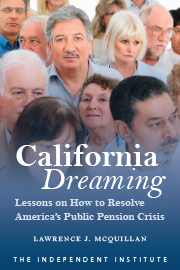Lost in the chatter about California’s budget crisis, electricity crisis, water crisis, and now recall crisis, is the workers’ compensation crisis. Yet it threatens to do more damage to the state’s business climate than any other factor. And workers’ comp will soon get worse.
California Insurance Commissioner John Garamendi has approved a 7.2 percent premium increase effective July 1. A state bureau believes that a 22-percent increase may eventually be needed to cover rising medical costs. This is terrible news for California employers who have already seen their workers’ comp costs triple since 1997, prompting many firms, including 3Com, Countrywide Financial, and Fidelity, to seek greener pastures outside the state. Even more discouraging for employers is that top officials are not focusing on reforms that would provide the greatest relief.
Fraud, says Garamendi, “is just one more skyrocketing workers’ comp cost driver that must be brought under control.” That’s true, but the major cost driver in California’s workers’ comp system is abuse, not fraud.
Fraud convictions require proof beyond a reasonable doubt. With such a high threshold, California will never prosecute its way to cost containment.
In fiscal 2001, district attorneys spent $17 million to get 367 fraud convictions, stopping $174 million in fraud-not a bad cost/benefit payback, but the savings are a drop in the bucket compared to total costs. Businesses will pay $20 billion in premiums this year, the highest in the nation. Yet, injured-worker benefits rank almost last.
Who’s getting all the money? Doctors, lawyers, and unscrupulous workers and employers use the rules to legitimately bilk the system of billions. Abuse, not fraud, is driving costs.
California’s workers’ compensation was established in 1913 as a “no-fault” system to redress major workplace injuries. Injured workers need not prove that an on-the-job injury was caused by a negligent employer to receive compensation. The system was designed to eliminate litigation over whether an employer is responsible, but it encourages filing of claims, however minor. About one million claims are filed each year, and strains and sprains are the leading injuries. Ninety percent of permanent partial disability claims concern minor injuries, which account for 80 percent of paid medical benefits.
Because of no-fault, litigation focuses on other issues such as whether the injury was sustained at work or how much compensation an injured worker deserves. In these areas, too, the rules invite abuse.
Injured workers are entitled to all medical care reasonably required to treat an injury. If contested, workers must only show the injury was “proximately” caused by employment, not predominantly caused.
California is the only state that pays permanent disability benefits without “objective medical findings” such as an x-ray. Of the $3.5 billion paid in indemnity benefits in 2001, nearly half were for permanent disability benefits, many paid on subjective complaints of pain-a boon to chiropractors who are now the leading medical providers in the system.
Between 1996 and 2001, insurers’ payments to chiropractors jumped 153 percent. What are chiropractors treating? Half the claims are for soft-tissue back injuries, the most frequently cited body injury.
Prices paid for medical services under workers’ comp are higher than those paid by other plans for identical services. Payments for hospital stays are 30 percent higher than employment-based health plans. Reimbursement rates for pharmaceuticals are 50 percent higher than Medi-Cal. Outpatient surgery reimbursements are 88 percent higher than Medicare.
Given the rules, it’s not surprising that medical costs are the fastest growing costs in the system, increasing by more than 100 percent since 1995, and now accounting for nearly half of total loss payments. Instituting comprehensive medical fee schedules would save employers more than $1 billion annually.
Lawyers benefit from the rules, too. A statutory provision entitles employees to reimbursement for legal fees incurred to prove a contested claim. Twenty percent of all claims are contested. Employee attorneys received nearly $200 million in 2000 and again in 2001. Insurers paid defense attorneys $294 million both years. Sixty percent of legal expenses arise from claims with minor injuries.
California’s workers’ comp system overly rewards doctors and encourages litigation and excessive filing of minor claims. Lawmakers must rewrite the rules before more damage is done.
Compensable injuries should be “predominantly” work related. Benefits should only be paid based on objective findings of doctors. Medical payments must be consistent with other plans. And, as much as possible, litigation should be minimized, which was the original intent.
Commissioner Garamendi should target fraud. But without major reforms, abuse will thrive, premiums soar, businesses flee, and the state will suffer. The same prescription applies to Florida, Missouri, West Virginia, and other states facing workers’ comp catastrophes.










